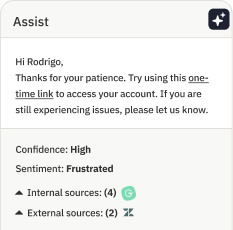Workforce management call center: How to optimize operations

We all know what it feels like to be completely overwhelmed at work. Whether it’s last-minute preparations for a big meeting or the scramble to complete a project on deadline, that rising stress is unmistakable. For call center teams, this dread can be non-stop, with agents struggling to manage customer interactions and managers playing whack-a-mole with schedules to handle fluctuating call demand.
But it doesn’t have to be this way! Smart workforce management (WFM) can change the game. WFM strategically aligns your team and resources with business needs, optimizing agent scheduling and performance based on agent availability, forecasted call volume, and revenue targets.
When agents aren’t over-or-under-worked and scheduling is streamlined, everyone wins. Here’s how effective contact center workforce management can boost employee engagement, call center productivity, and customer satisfaction.
What is workforce management in a call center?
Workforce management is all about the strategies, processes, and technologies that call centers use to optimize productivity and maintain service levels. Put simply, it’s making sure you have the right people with the right skill sets in the right place at the right time.
While this sounds straightforward, effective workforce management that keeps contact center agents, customers, and the company happy is no small task. With the fluctuating nature of call center work — think promotional periods or unexpected service outages — it’s tough to forecast demand and schedule everyone accordingly. And now, with call centers engaging customers across multiple channels like chat, email, and SMS, the challenge has only grown.
How workforce management works in a call center
Workforce management (WFM) is your ticket to keeping efficiency and morale high in your call center. Let’s break down how WFM in a call center works and the key components it needs to ensure success.
Forecasting
In workforce management, forecasting determines the expected workload for specific intervals, like days, weeks, or months. This involves analyzing historical data and current business trends, while also considering upcoming promotions and events that might affect call volume. Forecasting is the foundation of workforce management in call centers because it allows you to anticipate future call volumes and schedule the right number of agents for the expected workload.
Manual forecasting — predicting workloads without workforce management tools — has become increasingly challenging as consumer touchpoints have expanded. Customers aren’t just calling on the phone; agents now juggle chat, emails, SMS, and more. Effective workforce management ensures all these customer interactions are accounted for, optimizing everyone’s workload for their available time.
Scheduling
Once the upcoming workload has been forecasted, it’s time to create the schedule. Scheduling assigns agents to shifts to best meet customer demand while accommodating employee availability. By accounting for established call patterns, upcoming promotions, and more, scheduling optimizes agents’ productivity during their shifts.
Good scheduling ensures the right number of agents are available at the right times; great scheduling, however, leverages agent skills and experience to maximize customer satisfaction. Considering factors like seniority and scheduling preferences shows your top agents that they are valued. Plus, putting your best agents forward during crucial times can significantly boost your company’s reputation.
Scheduling is also crucial for avoiding overstaffing and understaffing. Having the wrong number of agents on a shift can negatively impact your company’s budget and customer service levels. Overworked or underutilized agents are far less likely to stick around. Staff retention is vital to your call center’s success, and it’s about more than just “numbers on a screen.” You’re dealing with the people who keep your call center running, so keep workloads consistent and morale high.

Intraday scheduling management
Intraday schedule management bridges the gap between what was forecasted and what is actually happening. It’s your ability to adapt and accommodate unexpected changes as they happen. Even the best-laid plans need a solid backup for intraday management to keep things running smoothly. For instance, if an agent calls in sick or another doesn’t show up, you might need to call someone else in. Or, managers might need to adjust the schedule to reassign agents to different communication channels.
Intraday scheduling management is similar to but distinct from real-time management. Think of intraday as day-by-day adjustments, while real-time management is minute-by-minute. In other words, how is the team doing right now? Is demand being met? Are agents performing their duties within the allotted time?
Key performance indicators (KPIs) like adherence can be tracked at both the team and individual levels. This can be a lot of work, but it’s essential. Call center analysts use this information to adjust schedules on the fly, ensuring calls are answered and neither customers' nor agents’ time is wasted.
Benefits of workforce management in call centers
Call center workforce management (WFM) offers more than just an easier scheduling process for managers. It provides several key benefits, including:
- A more positive customer experience. To improve the call center customer experience, your call center needs to be adequately staffed. This results in faster service which leads to happier customers who are more likely to stay loyal to your company.
- Improved employee satisfaction. Optimized schedules prevent agents from being overworked or underworked, which is crucial for employee satisfaction and retention. Satisfied employees with manageable workloads are less likely to burn out and more likely to stay with your company. According to the Center for American Progress, replacing an employee can cost 16–20% of their annual salary, not including recruitment costs or lost productivity during onboarding.
- Optimized operational efficiency. The ultimate goal for any call center is to match staffing levels to call volumes. This ensures a job well done while saving money on overstaffing. Using WFM tools streamlines this process, taking the guesswork and stress out of the equation.
What are the core challenges call centers face?
Call center managers face unique challenges that make workforce management crucial. The main reasons are twofold:
- The daily workload is determined by external factors. Call volume can be highly unpredictable. You’d love to know exactly how many calls your center will get tomorrow, but that’s rarely possible. Some trends are foreseeable, like increased calls during promotions or quieter periods at certain times of the year. Others, not so much — like sudden equipment failures or when Elon Musk tweets about your product.
- Call centers are often open 24 hours a day, 7 days a week. Managing a workforce for a round-the-clock operation is far more challenging than for a typical 9-to-5 setup. Ensuring you have the right number of people available at any given time is essential for providing consistent, reliable service to your customers.

Why call center WFM software is important
Workforce management in call centers is always a challenge, and it gets increasingly difficult as you add more employees, hours of the day, and days of the week. That’s why WFM software is crucial for call centers.
Our 2024 state of support tech report found that nearly 40% of survey respondents have plans to invest in new call center software this year, with nearly 28% of investments focused on WFM software.
However, according to Dimension Data, an estimated 41% of call centers still use manually created spreadsheets for workforce management instead of a WFM solution. This means 41% of contact centers aren’t maximizing their efficiency with automated forecasting and scheduling! Workforce management software not only creates schedules but also provides vital insights into staff productivity, adherence, contact volumes, and more — all of which can boost the success of your call center.
WFM software is a key part of your call center operation, contributing to the satisfaction of both your customers and agents. Here are just some of the features of WFM software:
- Saves money by streamlining. Manual, Excel-based forecasting and scheduling take a lot of time and often deliver only passable results. Letting WFM software handle this not only saves you time but also develops more accurate forecasts and schedules. This cuts down on unnecessary headcount, putting money back in your pocket.
- Helps agents prepare. Call volume forecasts aren’t just helpful for schedulers. Agents can better prepare for a shift when they know what workload to expect.
- Cuts paperwork. WFM software can automatically track time spent on calls and tickets, eliminating cumbersome paperwork that eats into productivity time.
- Creates intraday schedules. Intraday schedules can be extremely complex, but workforce management software takes the guesswork out and streamlines the process for you.
- Offers reports and metrics. Real-time reporting provides important insights into agent performance and can flag inefficiencies, allowing you to adjust on the fly and keep your call center on track.
Assembled, a workforce management solution
Running modern call centers is no simple feat. Agents are often expected to be available 24×7×365, and having the right number of agents to handle fluctuating, often unpredictable call volumes is as much an art as it is a science. Add chats, emails, and SMS to the mix, and forecasting and scheduling become even more daunting.
Luckily, you don’t have to juggle these tasks manually. Meet Assembled, a powerful all-in-one scheduling, forecasting, and reporting tool designed to support call centers.
Assembled is a cloud-based platform that offers accurate forecasts within 10% of your weekly call volume. It tracks real-time data for on-the-spot analysis and adjustments. Can your spreadsheet do that?
Our omnichannel WFM software helps analysts build SLA-proof schedules quickly, accommodating employee requirements, time zones, and more. It syncs with Google Calendar and Slack and seamlessly integrates with Zendesk, Kustomer, Intercom, and more. Plus, it’s future-proof: Assembled will scale with your company as it grows. Ready to get started? Request a demo today!





